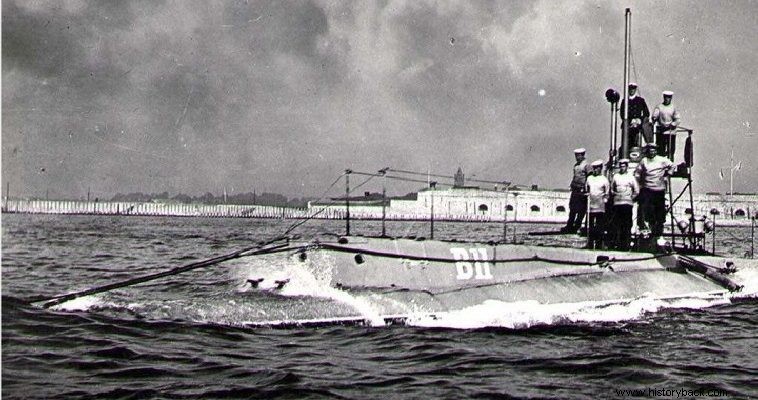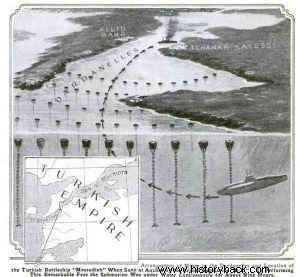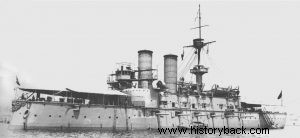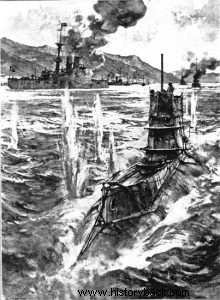
The submarine weapon did not get the recognition it deserved in Britain. And this made perfect sense, considering that the Royal Navy, then the most powerful in the world, had, in 1914, over 60 battleships, old and new. The Royal Navy's reliance on its battleship line of battle automatically made submarines the poor cousins of special-purposes.
When the Ottoman Empire declared war on ANTATE on 30 October 1914, the British and French Navies had deployed in the Eastern Mediterranean some old ships, under the leadership of Vice-Admiral Carden. Shortly after the start of operations, Carden's forces were reinforced by three submarines from Malta, the B-9, B-10 and B-11.
Pownall was looking for an offensive role for his submarines. Then the question of penetrating the Dardanelles straits and striking the enemy ships at its bases was raised for the first time. Pownall, along with B-11 commander Norman Holbrook, addressed this very issue in their meeting.
The B-11 was already an old, by 1914 standards, submarine. For a submarine or surface vessel to venture into the Dardanelles straits was at that time a feat in itself. The Turks had planted five extensive minefields , across the straits and an even more extensive one, right after, across the straits. Also the strong sea currents were an obstacle. Nevertheless, the decision was made for B-11 to enter the straits.
Audacious Penetration
Early in the morning of Sunday, December 13, 1914, everything was ready. The B-11 and the auxiliary vessel 'Blenheim' moved together towards the entrance of the straits, with the submarine 'glued' to the starboard side of the vessel so as to be invisible. It was still pitch dark – 04.15 in the morning – but the prudent Holbrooke didn't want to leave anything to chance.
The two ships came within 3 nautical miles (nm) of each other. from the entrance of the straits. There the submarine was left alone. Sailing slowly on the surface, the submarine arrived, at dawn, at a distance of one nm from Cape Helli.
The submarine started with the men lost in thought. They all knew how dangerous their venture was. The night before, they had all written farewell letters to their families which would be delivered if the submarine did not return.
The submarine dived to 15m. depth and found itself in the Black Sea current zone, "cutting" speed and consuming valuable electricity from the batteries. The submarine was traveling at a speed of 4 Knots, but due to the current it was being pushed forward at a speed of only 2 Knots.
Anxiety in the small iron carcass of the B-11 was at its peak. Holbrook realized this and immediately ordered breakfast for the crew. Soon the smells of ham, jam, tea and butter calmed the men's tense nerves a little.
Attack
The time was approaching 08:30 and the submarine's batteries had already been drained by two-thirds. Nevertheless, the submarine continued. Soon he found himself in front of the first known minefield. Holbrooke ordered a dive to 24m. This depth was theoretically beyond the capabilities of the submarine, but the hull held out .
At 09.40 the submarine had entered the straits. Suddenly, he saw a large ship. It was the old Turkish battleship "Messudieh" , anchored at a distance of about 1,700 m from the bow of the submarine, at an angle of 45°.
With difficulty the submarine reached a distance of 800 m from the stern of the battleship and launched a torpedo which seriously hit it. As the torpedo hit the battleship and black smoke began to envelop it, the Turkish gunners spotted the B-11's periscope and began firing at it with every available weapon.
The sea began to boil from the shells around the submarine, which seemed to have no hope of escape. At the same time a catachonous splash was heard and the "Messudieh" capsized, trapping many of the almost 700 men of its crew in its wake and dragging several of them to its wet grave forever.
Escape
Now Holbrook had to lead the submarine out of the bay. "Scuba diving. Back full speed,” he ordered and the sub with the last nuggets of electric motor power slowly obeyed. However, due to damage to the compass, he was forced to go to periscopic depth. Suddenly Turkish patrol cars appeared. The commander of the B-11 ordered a dive but the submarine "found" itself in the shallows with its tower visible. Despite this, the submarine continued to sail "scraping" the bottom.
"The electric motor was literally blowing the blades, but it was driving us to the rescue," Holbrook said. He turned the rudder to port and let the current drive his little submarine out of the straits, which stretched ahead for another 16 nm.
With the compass out of order Holbrook decided not to risk another passage under the minefields. It would sail at periscopic depth between them. Absolute silence prevailed in the submarine. Only the heavy breaths from the stifling air could be heard, along with a few sharp words-orders from Holbrook's mouth. Skillfully the B-11's commander guided it, visually, through the minefields to the exit of the straits.
They spent 10 nm. perceiving here and there the Turkish shells from the coastal guns exploding near them. Holbrooke in reply ordered lunch to be served! Finally at 14.10 the submarine surfaced, 2 nm. west of Cape Hellas and saw two British destroyers waiting to escort it.
When the small hatch in the submarine's turret was opened, the sailors of the destroyers that had been lit on its deck saw greenish-yellow vapors coming out of its interior!
It was the poisoned air that the men of the submarine were breathing for a while. There was such a lack of oxygen inside the submarine that it took more than half an hour to start the boat's gasoline engine!


The Turkish battleship Messudieh.

